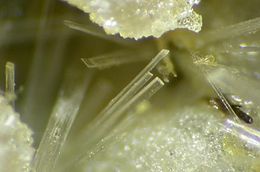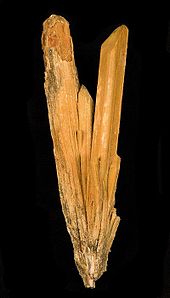| Cervantite | |
|---|---|
 Microscopic cervantite crystals from Slovakia (3 mm field of view) Microscopic cervantite crystals from Slovakia (3 mm field of view) | |
| General | |
| Category | Oxide mineral |
| Formula (repeating unit) | SbSbO4 |
| IMA symbol | Cvn |
| Strunz classification | 4.DE.30 |
| Crystal system | Orthorhombic |
| Crystal class | Pyramidal (mm2) (same H-M symbol) |
| Space group | Pbn21 |
| Unit cell | a = 5.43 Å, b = 4.81 Å, c = 11.76 Å; Z = 4 |
| Identification | |
| Color | Yellow to nearly white |
| Crystal habit | Microscopic acicular crystals; massive |
| Cleavage | Excellent on {001}, distinct on {100} |
| Fracture | Conchoidal |
| Mohs scale hardness | 4–5 |
| Luster | Greasy, pearly, earthy |
| Streak | Pale yellow to white |
| Diaphaneity | Semitransparent |
| Specific gravity | 6.5 |
| Optical properties | Biaxial |
| Refractive index | nα = 2.000 nγ = 2.100 |
| Birefringence | δ = 0.100 |
| Dispersion | relatively weak |
| References | |
Cervantite, also formerly known as antimony ochre — is an antimony oxide mineral with formula SbSbO4 (antimony tetroxide).
It was first described in 1850 for an occurrence in Cervantes, Galicia, Spain, and named for the locality. The mineral was questioned and disapproved, but re-approved and verified in 1962 based on material from the Zajaca-Stolice district, Brasina, Serbia. It occurs as a secondary alteration product of antimony bearing minerals, mainly stibnite.

References
- Warr, L.N. (2021). "IMA–CNMNC approved mineral symbols". Mineralogical Magazine. 85 (3): 291–320. Bibcode:2021MinM...85..291W. doi:10.1180/mgm.2021.43. S2CID 235729616.
- Mineralienatlas
- ^ Handbook of Mineralogy
- ^ Mindat.org
- Webmineral data
- James Dwight Dana A. M., Brush G. J. A system of mineralogy : Descriptive mineralogy, comprising the most recent discoveries. — New York : J. Wiley & Sons, 1884.
This article about a specific oxide mineral is a stub. You can help Misplaced Pages by expanding it. |